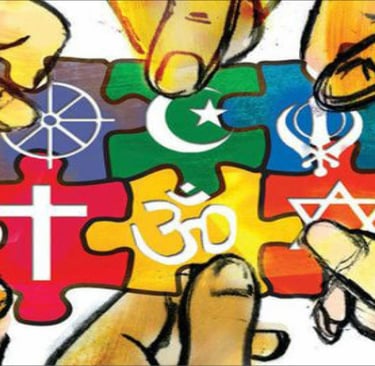The Essentiality Doctrine: Freedom of Religion and Judicial Interpretation in India
INDIAN POLITY


The Constitution of India, under Article 25 to Article 28, safeguards the freedom of religion, promising every citizen the right to profess, practice, and propagate religion. However, this right is not absolute. Indian judiciary has, over the years, interpreted religious freedom through the lens of what is termed the "Essentiality Doctrine" — a judicial tool employed to determine which practices constitute an essential part of a religion and are hence protected under the Constitution. This doctrine plays a critical role in balancing religious freedom with other constitutional mandates, such as public order, morality, and health.
Understanding the Essentiality Doctrine
The Essentiality Doctrine, first established by the Supreme Court in the 1954 case of The Commissioner, Hindu Religious Endowments, Madras v. Sri Lakshmindra Thirtha Swamiar of Shirur Mutt, is a principle that examines if a particular practice is an essential part of a religion. The Court, by interpreting Article 25, held that only those rituals, tenets, or beliefs integral to a religion are protected under the right to freedom of religion. It, therefore, granted the judiciary the power to evaluate and interpret religious practices.
This doctrine ensures that practices considered essential to the religion are protected from undue interference by the state, while those deemed non-essential can be subject to state regulation for promoting social welfare and reform.
Major Cases and Judicial Interpretation
1. Shirur Mutt Case (1954)
This landmark case laid the foundation for the Essentiality Doctrine. The case revolved around the Madras Hindu Religious and Charitable Endowments Act, 1951, which aimed to regulate certain aspects of Hindu religious institutions. The petitioner, the head of the Shirur Mutt, argued that this Act violated his right to religious freedom under Article 25.
The Supreme Court, in its judgment, held that only essential religious practices are protected by the Constitution. The Court emphasized that religious denominations have the right to manage their own affairs in matters of religion but that practices outside the "essential" scope could be regulated. This ruling established the precedent that only essential religious practices would enjoy constitutional protection.
2. Durgah Committee, Ajmer v. Syed Hussain Ali (1961)
In this case, the Court further nuanced the essentiality doctrine by stating that practices which have no relevance to religion and are merely “superstitious beliefs” cannot be considered essential. The Durgah Committee case involved the regulation of religious endowments and practices at the dargah (shrine) of Khwaja Moinuddin Chishti in Ajmer.
The Court ruled that practices not integral to religion were open to state regulation, upholding that the state could indeed regulate practices which do not form the “core” of religious beliefs. This case reinforced the judiciary’s role in interpreting and defining what is “essential” to a religion.
3. Seshammal v. State of Tamil Nadu (1972)
In this case, the Supreme Court examined the Tamil Nadu Government's regulation regarding the appointment of priests in Hindu temples. The petitioners argued that the regulation violated religious freedom by infringing upon an essential aspect of temple rituals.
The Court, however, ruled that appointment of temple priests was not an essential religious practice, emphasizing that only practices central to a religion are protected under Article 25. Thus, state intervention was permissible in this context, affirming that administrative practices are often distinct from core religious beliefs and can be regulated.
4. Bijoe Emmanuel v. State of Kerala (1986)
This case involved three Jehovah’s Witness children who refused to sing the national anthem, contending that their religious beliefs did not allow them to sing it. The Court ruled in favor of the children, emphasizing that they were standing respectfully during the anthem and that their silent non-participation did not disrupt public order or disrespect the anthem.
The judgment illustrated the Court's willingness to protect religious beliefs even when they were perceived as non-conformist, as long as they did not infringe upon public order, morality, or health. This case highlighted the importance of individual religious beliefs as part of the essentiality doctrine.
5. Sabarimala Case (Indian Young Lawyers Association v. State of Kerala, 2018)
The Sabarimala verdict was among the most contentious rulings related to the essentiality doctrine. The case questioned the constitutionality of the temple's practice of prohibiting women of menstruating age from entering, citing it as an essential religious practice rooted in the belief of maintaining purity.
The Supreme Court, however, ruled that this exclusionary practice was not an essential religious practice. It argued that barring women on physiological grounds amounted to gender discrimination and violated their right to equality (Article 14) and freedom of religion (Article 25). This judgment underscored that practices discriminatory in nature may not be protected under the essentiality doctrine.
6. Shayara Bano v. Union of India (Triple Talaq Case, 2017)
The triple talaq case is another crucial instance where the essentiality doctrine was applied. Here, the Court examined the practice of instant triple talaq (talaq-e-biddat) under Islamic personal law. The petitioners argued that this practice was unconstitutional and violated women’s rights to equality and dignity.
The Supreme Court held that triple talaq was not an essential practice in Islam, as it was not mandated in the Quran and had been banned in several Islamic countries. Consequently, the practice was struck down, marking another milestone where the Court negated a religious practice on grounds of essentiality, reflecting the judiciary’s commitment to balancing religious freedom with fundamental rights.
7. Hijab Ban Case (Karnataka, 2022)
In the recent case addressing the ban on hijabs in Karnataka educational institutions, the Karnataka High Court upheld the government’s directive to disallow hijabs in classrooms, concluding that the hijab is not an essential religious practice in Islam. It reflects how courts continue to interpret the essentiality doctrine in new contexts where individual rights, educational policy, and religious expression intersect.
Criticisms of the Essentiality Doctrine
While the essentiality doctrine is central to determining religious freedoms, it has been criticized for several reasons:
1. Judicial Overreach: Critics argue that the doctrine allows the judiciary to determine what constitutes an essential practice in religions, a role traditionally reserved for religious authorities.
2. Inconsistent Application: The subjective nature of the doctrine has led to inconsistent judgments. While some practices are considered essential, others are not, even within the same religion, leading to ambiguity and unpredictability.
3. Secularism Debate: The doctrine has fueled debate on India’s secularism, with critics arguing that secularism should imply a "hands-off" approach where the state does not interfere in religious practices unless they violate fundamental rights.
4. Gender Equality vs. Religious Rights: The doctrine often comes into conflict with gender equality, as seen in cases like Sabarimala and Shayara Bano. Critics argue that religious rights should not override constitutional values of equality and non-discrimination.
Conclusion
The Essentiality Doctrine is a significant aspect of the Indian judiciary’s approach to interpreting religious freedom under the Constitution. By demarcating essential religious practices from non-essential ones, the judiciary ensures that while religious practices are respected, they do not impede other fundamental rights or constitutional mandates.
However, as society evolves, so do its values and ideals. As seen in cases like Sabarimala and Triple Talaq, the Court has increasingly aligned its judgments with the principles of equality and individual rights, reflecting the dynamic nature of the Essentiality Doctrine. For UPSC and MPSC aspirants, understanding the doctrine’s impact on religion-state relations is essential, as it is not just a legal issue but one that deeply influences India’s social fabric and constitutional vision.
